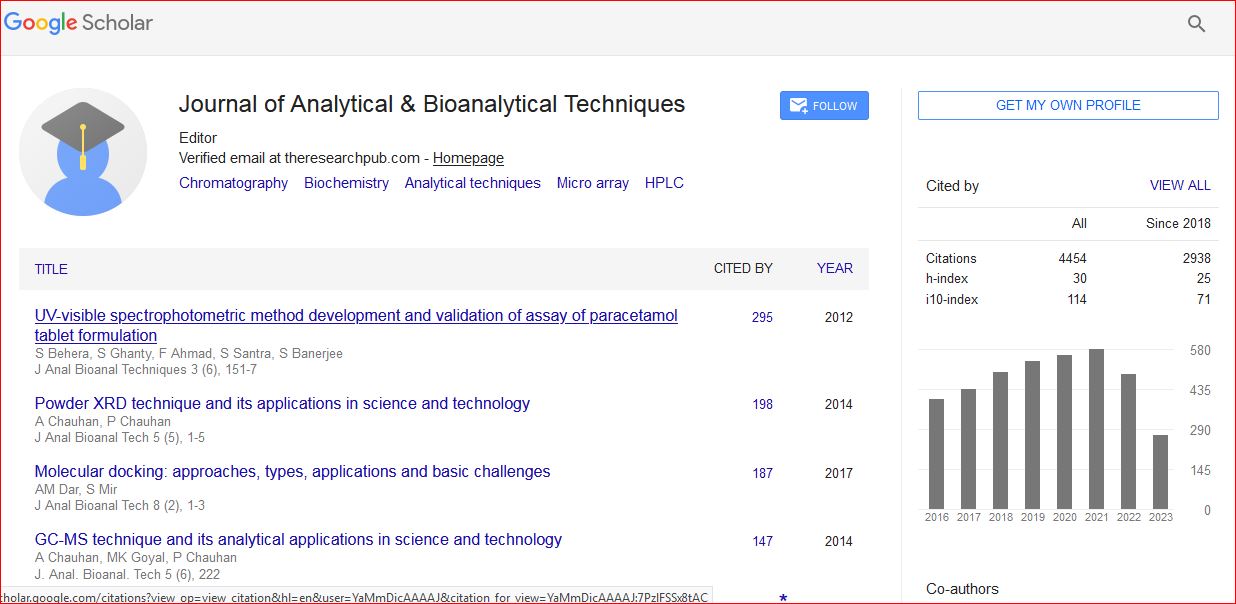Research Article
Ionization Polarity as a Cause of Matrix Effects, its Removal and Estimation in ESI-LC-MS/MS Bio-analysis
Chinmoy Ghosh1,2*, Chandrakant P. Shinde2 and Bhaswat S. Chakraborty11Contract research organization, Cadila Pharmaceuticals Limited, 1389-Trasad road, Dholka, Gujarat, India
2School of Studies in Chemistry, Jiwaji University, Gwalior, M.P., India
- *Corresponding Author:
- Chinmoy Ghosh
Research Scientist
Contract Research Organization
Cadila Pharmaceuticals Limited
1389, Trasad road, Dholka-387 810
Dist – Ahmedabad, Gujarat, India
Tel: +91-2714-221481/83/84
Fax: +91-2714-221848
E-mail: chinmoy_ghosh@yahoo.com
Received date: September 13, 2010; Accepted date: November 01, 2010; Published date: November 03, 2010
Citation: Ghosh C, Shinde CP, Chakraborty BS (2010) Ionization Polarity as a Cause of Matrix Effects, its Removal and Estimation in ESI-LC-MS/MS Bioanalysis. J Anal Bioanal Tech 1:106. doi: 10.4172/2155-9872.1000106
Copyright: © 2010 Ghosh C, et al. This is an open-access article distributed under the terms of the Creative Commons Attribution License, which permits unrestricted use, distribution, and reproduction in any medium, provided the original author and source are credited.
Abstract
Matrix effect is the effect on an analytical method caused by all other components of the sample except the specific compound to be quantified. Matrix effects and selectivity issues have long been associated with bioanalytical techniques. A number of approaches have been investigated to improve reproducibility and robustness of LC-MS-MS methods that are subjected to matrix effects. In the present research work the role of ionization polarity on matrix effect was studied. Enalapril and its metabolite were analyzed in positive and negative polarity by using ESI-LC-MS/MS. Matrix factor (MF) was determined to evaluate the matrix effects in different polarities. Two different concentration levels of each analyte were used to determine the MF. In positive polarity the MF at two different concentration levels were 0.6353 & 0.6496 for enalapril and 0.6885 & 0.6770 for enalaprilat, whereas, the MF in negative polarity at two different concentration levels were 0.8203 & 0.7717 for enalapril and 1.1124 & 1.0915 for enalaprilat. These data showed approximately 30-35% ion suppression in positive polarity for both the analyte, but approximately 20% ion suppression for enalapril and 10% ion enhancement for enalaprilat in negative polarity. So, matrix effects depend on the ionization polarity also.

 Spanish
Spanish  Chinese
Chinese  Russian
Russian  German
German  French
French  Japanese
Japanese  Portuguese
Portuguese  Hindi
Hindi 
